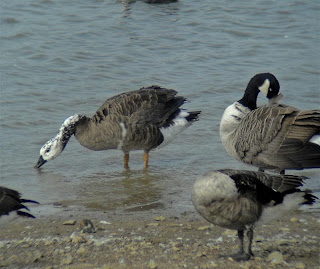There seemed to be an amazing number of elderly people there, some being even older than us, all intent on making the most of the hot and sunny weather. We drove around for a while before returning to the car park but there were still no spaces available.
Rather than waste the day, we headed for the Cuckmere Valley, between Seaford and Beachy Head, and parked on the western side of the valley by the Golden Galleon pub. This side of the valley is much quieter than the eastern side and normally produces a few good birds (and the parking is free too!).

It was immediately obvious that many hirundines were present and I estimated that at least 150 House Martins and 300 Swallows were in the area.
Heading along the track towards the sea, Sue pointed out some birds flitting down from the bushes and catching insects on the path - fours Whinchats.


A little further on, I could hear two Greenshanks calling but failed to spot them but, whilst scanning the grazing marsh, I picked out a Wheatear and a Whimbrel. Also out on the grass were 27 Curlews and an amazing count of 32 Little Egrets.


I also picked out a wader that I was initially unable to identify. My gut feeling was that it was a Wood Sandpiper as it had a very prominent supercilium but, after it headed for a ditch and gave better views, it was apparent that it was just a Common Sandpiper.

In the bushes along the path there were about a dozen Chiffchaffs, a couple of Willow Warblers and a Common Whitethroat, but not much else.
The number of Meadow Pipits in the area must have been well over 200 birds, they were everywhere.
Eventually we reached the Coastguards Cottages by the beach and went in search of a bench to sit and have a coffee.


As we headed up the cliff, we found that there was a film shoot in progress and as we walked past, we noticed Hugh Dennis of 'Mock the Week' and 'Outnumbered' there.


We found a bench a little further on and sat and ate our sandwiches and downed our coffee whilst scanning the sea. An hour's seawatch produced two Common Terns - but nothing else!
As we headed back, the film crew had packed up and were all sitting on the grass and Sue had me in stiches when she said that Hugh Dennis had smiled at her. It seemed to be the highlight of the day for her. I now dread watching him on the TV as I know that, every time his face appears, Sue is going to remind me that he smiled at her!
We returned by the same route and noted that the Whimbrel was still present and a couple of Oystercatchers were out on the grazing marsh with the two elusive Greenshanks now on show.


Most of the hirundines had now disappeared but Sue picked out what may have been the cause - a distant Peregrine flying east.
A Kingfisher flew along a ditch at a rate of knots and that was the last notable bird of the day.
Graham & Sue




































